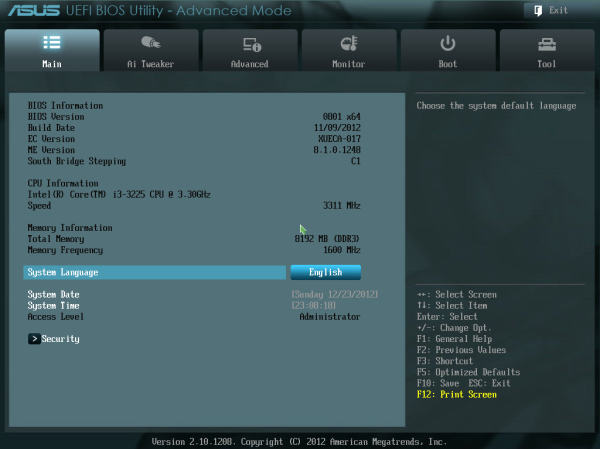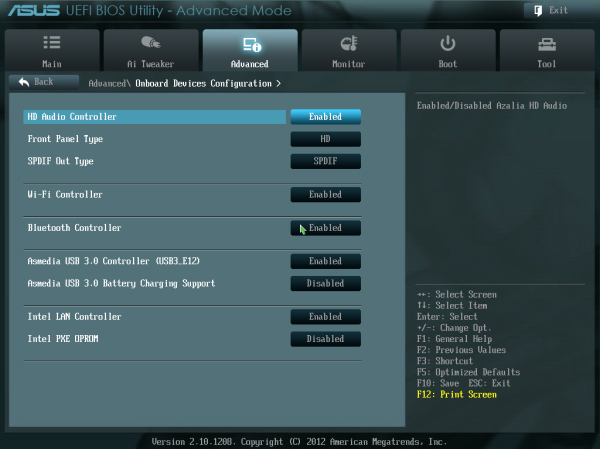Z77 mITX Round-Up: Five of the Best – MSI, Zotac, ASRock, EVGA and ASUS
by Ian Cutress on December 31, 2012 7:00 AM EST- Posted in
- Motherboards
- MSI
- ASRock
- EVGA
- ZOTAC
- Asus
- Ivy Bridge
- Z77
- mITX
ASUS P8Z77-I Deluxe BIOS
The BIOS from ASUS has been a rock solid part of their motherboard package since the advent of graphical BIOSes on mainstream motherboards hit a couple of years ago. ASUS divides functionality at the top level, providing an easy mode with images and bars to help identify the main points of the product, as well as a one button click for greater performance and boot priority. The other side of the coin is in advanced mode, where the feature sets are laid out to make sense to the user, and all options take the form of the old text-based BIOS. This lays the plans down for other features of the system, like USB BIOS Flashback.
While the BIOS from ASUS is one of the best on offer out of all the motherboard manufacturers today, there is room for improvement in all of them. The beating heart of a graphical BIOS should be functionality, representation of those functions, and usability. Very rarely do I ever see all three meshed together. Part of this is down to the size of the BIOS – even ASUS limit themselves to a 64 megabit BIOS chip, meaning 8 MB of storage to play around with for all the initialization procedures and protocol. It makes efficiency important in BIOS coding, and vendors are unwilling to double the size of the BIOS because of the additional cost. With the motherboard market in decline, innovation in this area is unlikely any time soon, but with bulk buying deal, ASUS could lead that charge. Then all would be left to do is to encourage the BIOS engineers and developers to create something.
The ASUS BIOS however is one of the best available today. The front ‘easy’ mode screen is full of information that a system builder or diagnostician needs before opening up a case – we get access to the motherboard model, BIOS version, CPU installed, the size of the memory installed, CPU and system temperatures, fan speeds, voltages and the boot order. There are options to apply a basic turbo mode, a power saving mode, a Boot Menu to select which device to boot from and shortcuts to advanced mode features.
Stepping into the advanced mode gives us a tabbed interface of options. When first entering we are presented with the Main screen, which offers similar data to the easy mode, as well as security options.
The next tab along is the AI Tweaker, where all the cool stuff happens. Users can choose to overclock their system through this menu, with options for CPU multiplier, CPU base frequency, MultiCore Enhancement, XMP on the memory, separate memory straps, and associated voltages. There are separate menu options as well to deal with memory timing, power management, and the DIGI+ VRMs.
The Advanced menu is for enabling and disabling the functionality on board – this extends to processor functionality (to disable sleep states), SATA functionality, USB functionality, Rapid Start, Smart Connect, integrated graphics, PCIe configuration and onboard devices such as audio, network, WiFi and Bluetooth.
Fan controls are hidden in the Monitor tab, which gives us details on temperatures, fan speeds and voltages. The fan options are relatively basic compared to those offered in the OS, despite the fact that the graphical BIOS way of thinking should offer some form of stepped graphical control over fan speeds. I look forward to seeing it on future BIOS designs.
The Boot tab allows users to adjust the boot order or select a device for a single boot override. Users of Windows 8 can also take advantage of the Fast Boot option which reorganizes the initialization procedure at POST in exchange for not being able to get into the BIOS without a BIOS reset or selecting an OS software option.
The ASUS BIOS also supports BIOS flashing if the correct file is on an attached storage device, although not directly from the internet. A newer feature in ASUS’ offering allows users to save BIOS profiles direct to a USB stick as well.
Another feature to mention is USB BIOS Flashback, which allows users to update a BIOS without having a CPU, memory or a graphics device installed. With the correct BIOS file and filename on a USB stick, by pressing a button on the IO panel, it will update the BIOS onboard (exact procedure is listed in the manual).























54 Comments
View All Comments
Sabresiberian - Tuesday, January 1, 2013 - link
Thanks for the great comparison review!It looks like there is a little mistake in the spec list for the Asus board, which shows it having a mini-PCIe connector. I would love it if it did, but I didn't see it on the board and it isn't mentioned in other spec lists.
It is important to me because I would ideally need connection for both a graphics card and a sound card (which I believe I could do through a mini-PCIe to PCIe x1 adapter if needed). This makes the EVGA Stinger the choice for me here, though the Asus board is the one I would prefer to buy.
I am truthfully a little disappointed in the EVGA board, which seems all too common with EVGA products in general these days. Great support is still there, but I'd rather they build bleeding edge components and not have to find out whether or not their support is as good as people say it is. The Stinger is a good board to be sure, and the Intel LAN alone puts it in the category of "will buy" for me, but I was hoping it would be something that would match or beat the Asus P877-I, and it just doesn't.
Foeketijn - Tuesday, January 1, 2013 - link
When you take overclocking out of the equation, B75 has it all, for the price just a tiny bit north of the old H61 chipset. Support for IB features (1600Mhz DDR3, PCI-e 3.0), Native Sata III, USB 3.0.It wasn't intended for the DIY market but fits the bill perfectly in my opinion. Only the very very few who need to OC, +16Gb ram or multiple SSD's @ full 6 Gb/s need the Z77 chipset.
The only thing is, that us mere mortals can't predict is, if a much cheaper chipset is used, did the OEM also cheapskate on the critical parts to? I would love to see some in-depth component analysis which I see for example, when a PSU is taken apart.
Which components are used? how well is the soldering done, does it still work at a sauna lanparty, etc.
I might be alone in this, but I would find that much more valuable information than all the performance benchmarks together (race to the bottom, be dammed!).
Including the northbridge in the CPU made motherboard and CPU reviews so predictible (or borring).Since then, I'm only interested in stability, ease of installation (nicely covered) and practical use (fan controll, MEM compatibility ect).
<offtopic> Oh I loved the XP-m 2500+ siverpainting 2001 era where you actually could get a noticeable improvement of performance and not necessarily have to sacrifice stability or risk bankruptcy</offtopic>
vanwazltoff - Tuesday, January 1, 2013 - link
i picked up an asus p8z77-i deluxe/wd before christmas and made a beast gaming computer out of it with an i5-3750k OCed to 4.5ghz and a gtx670 =]vanwazltoff - Tuesday, January 1, 2013 - link
*3570kBeaver M. - Tuesday, January 1, 2013 - link
Loved the POST screen measurements and the DPC latency testing. Something you dont see every day. Actually Ive never seen it, and yet I always wanted to know those.However I am not really interested in the Z77s, since they have a horrible layout for my needs. Only the Asus one comes close to what I need, but I just dont buy Asus anymore because of several very bas experiences.
So, I wish you would also test the B75 and H77s.
paksoy - Tuesday, January 1, 2013 - link
I love the features of this Asus mobo, but i want to use it in a really small form factor case like the Antec ISK 110 VESA Case.http://www.anandtech.com/show/6192/antec-isk-110-v...
I'm just worried that the height of the VRAM board would prevent it from using it with this case.
mi1stormilst - Tuesday, January 1, 2013 - link
I still opted for the Gigabyte Z77N and love it...Sivar - Wednesday, January 2, 2013 - link
Does this refer to the ALC889 playing an audio file encoded at 192KHz?If so, does it really matter? Failing a test is never a good thing, but I know of no widely available 192KHz audio source, and such a source would have no benefit, nor would a 96KHz source.
cjs150 - Wednesday, January 2, 2013 - link
I am a happy user of the AS Rock board in a silent HTPC. It works exceptionally well. However it is clear that some work still needs to be done on motherboard design.MSata on back is excellent - now can we have it as SATA 3 because the better MSata SSDs are all Sata 3.
Placement of Sata connectors is often awkward on these boards. On edge and at right angles please.
Similarly I would love it if someone either did the 24 pin ATX power connector at right angles or someone manufactured a right angled converter that did not require de soldering the motherboard connector. Cable management in Mini-OTX is very hard and that would really help.
Finally, careful choice of RAM can eliminate issues Ian had about the closeness of the CPU socket preventing the use of many after market coolers. I use the Samsung green low profie memory, which is so low that any after market cooler can be used (and runs at 1.35v, is an unbelievably good overclocker and reasonably priced!)
romrunning - Wednesday, January 2, 2013 - link
As has been mentioned previously, the H77 chipset is great for those who do not need overclocking. I've used the Intel DH77DF, and I heartily recommend it. Since the DH77DF has an eSATA port (not too common), I've even been able to keep an eSATA dock that I used before USB 3.0 was more readily available. If you install this board into a Fractal Design Node 304 case, you can use all of the SATA ports as well. I've used it with a Silverstone SG05 case, and the loudest part of my setup is the fan on the graphics card (Radeon 7850).One thing I've noticed, though, is the relatively low mic input from the front audio. Not sure if this is common to the Realtek ALC8xx chip series, but even after boosting the gain in Win7 to +30db, it still isn't quite as loud as an older AMD board I previously had (which didn't need a boost at all).